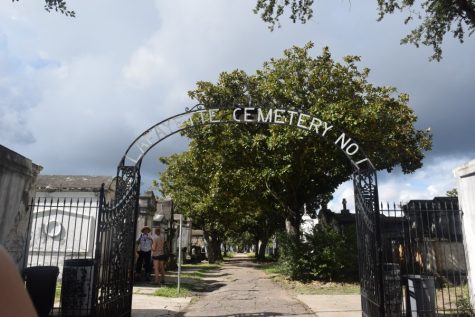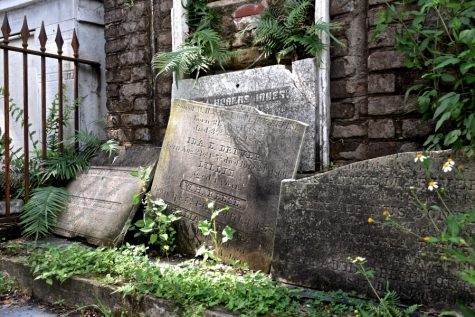The Walking Dead: Cemeteries central to New Orleans Culture
New Orleans is sinking two inches per year, and it would be quite fitting if the last thing sticking up out of the water were the tombs of the dead. The dead are buried above ground in New Orleans because frequent flooding once caused corpses to often surface. While the mausoleums are practical in nature, they often capture more attention for their intricacy and beauty.
The city’s structural issues, as well as its age and lack of upkeep, caused some of its cemeteries to fall into disrepair until Save Our Cemeteries helped recover the tombs with the help of the Archdiocese. New Orleans Catholic Cemeteries owns and operates 13 cemeteries in the city: St. Louis 1, 2, 3; St. Patrick 1, 2, 3; St. Roch 1 and 2; St. Joseph 1 and 2; St. Vincent 1 and 2; and St. Charles Cemetery.

Lafayette Cemetery No. 1 is one of many cemeteries in the Uptown area that attract visitors.
Sherri Peppo has been executive director of New Orleans Catholic Cemeteries since 2014, and she has been with the organization for 29 years.
“Each of the New Orleans Catholic Cemeteries has its own story of how it came about,” she said. “Each of the cemeteries has its own appeal for different reasons.”
For example, St. Patrick was established in 1841 for Irish settlers who perished in the yellow fever epidemic.
“St. Roch No. 1 has a chapel from 1876 that was dedicated by the pastor of the Holy Trinity Church as a promise if none of his parishioners died from the yellow fever epidemic” Peppo said.
St. Louis Cemetery No. 1 is located on the edge of the French Quarter and was established in 1789, making it the oldest cemetery in New Orleans. Residing here is Homer Plessy, plaintiff in the famous 1896 Supreme Court case Plessy vs. Ferguson, which upheld “separate but equal” segregation. Also here is the famous voodoo priestess Marie Laveau.
Amidst the tombs and crumbling bricks is a new controversial white pyramid belonging to none other than Nicolas Cage, who has reserved the space for his corpse when he passes. The cemetery was closed to the public in 2015 but can still be entered with a registered tour guide.
Only $1 per visitor per tour is collected by Catholic Cemeteries, according to Peppo, which is insignificant considering the cost of cemetery upkeep. A few years ago, the brick walls of St. Louis No. 1 had to be restored at a cost of $500,000, and this cemetery gets about 200,000 visitors per year. St. Louis Cemetery is the only one restricted to visitors.
In the Gothic chapel of St. Roch Cemetery No. 1, there are prosthetics, crutches, coins and thank-you notes — an interesting mix of paraphernalia that is a favorite for New Orleans tours to point out, especially on haunted tours.

Age and lack of maintenance have allowed many facets of New Orleans cemeteries, such as tombstones and the mausoleums themselves, to fall into disrepair.
Lafayette Cemetery No. 1 in the Garden District is open for the public, popular with visitors and a favorite for filming. “American Horror Story,” “The Originals,” “Double Jeopardy,” “NCIS: New Orleans” and many music videos have been filmed here.
Old Charity Hospital & Katrina Memorial Cemetery is the final resting place for many who died at the hospital during the yellow fever epidemic. This cemetery is different from others in New Orleans because the corpses are buried underground for fear that yellow fever would spread to living visitors from the corpses. It was established in 1848 for unidentified persons, so the tombs do not have any markers. The land has been raised several feet to account for flooding. The Katrina Memorial was added in 2007 in remembrance of the victims of the hurricane, many of whom remain unidentified and unclaimed.
Those who have the time to venture a little farther should check out Metairie Cemetery in Old Metairie. It is a 65-acre cemetery built on a former horse-racing track. It is a beautiful, landscaped park in addition to a classic New Orleans cemetery with above-ground tombs. This is the final resting place for several Civil War generals, Louisiana governors, artists, writers and Al Copeland, founder of Popeye’s Fried Chicken.
While cemeteries are a well-loved facet of New Orleans culture, there are still some guidelines to abide by when exploring. These cemeteries are still active, and families are burying their dead regularly, so be sure to respect any memorial processions when visiting. Photography is allowed in all of the cemeteries, so feel free take a lot of pictures.
Your donation will support the student journalists of Tulane University. Your contribution will allow us to purchase equipment and cover our annual website hosting costs.




Carolyn • Apr 5, 2018 at 3:15 pm
Hey Bryce,
Thanks for the mention! Come take a tour with us sometime.
Carolyn Sinclair
Tour and Marketing Manager
Save Our Cemeteries.